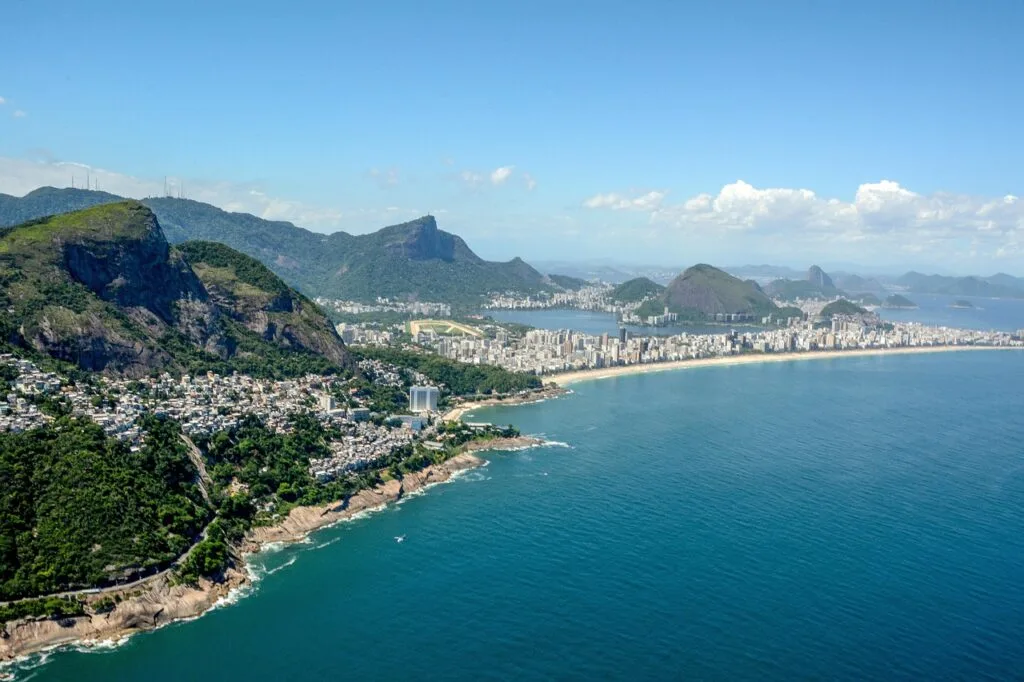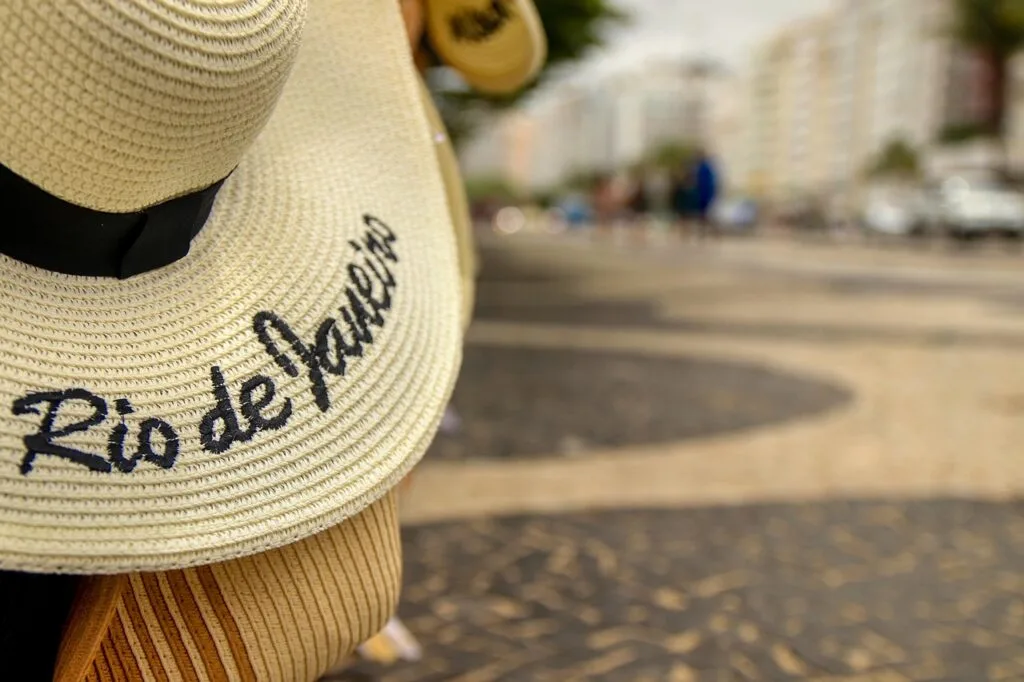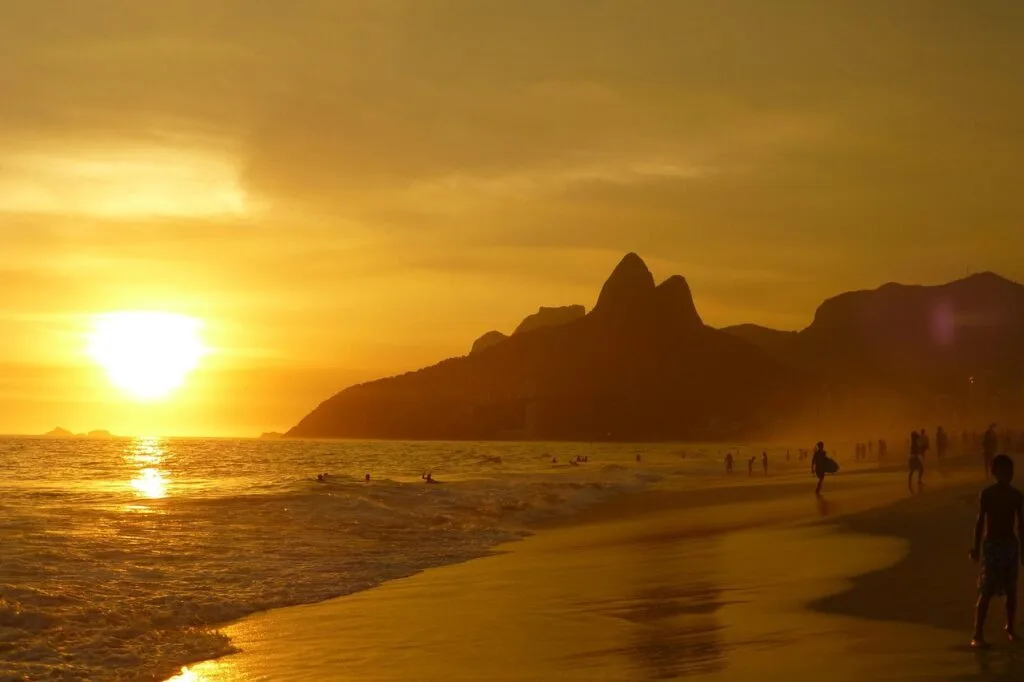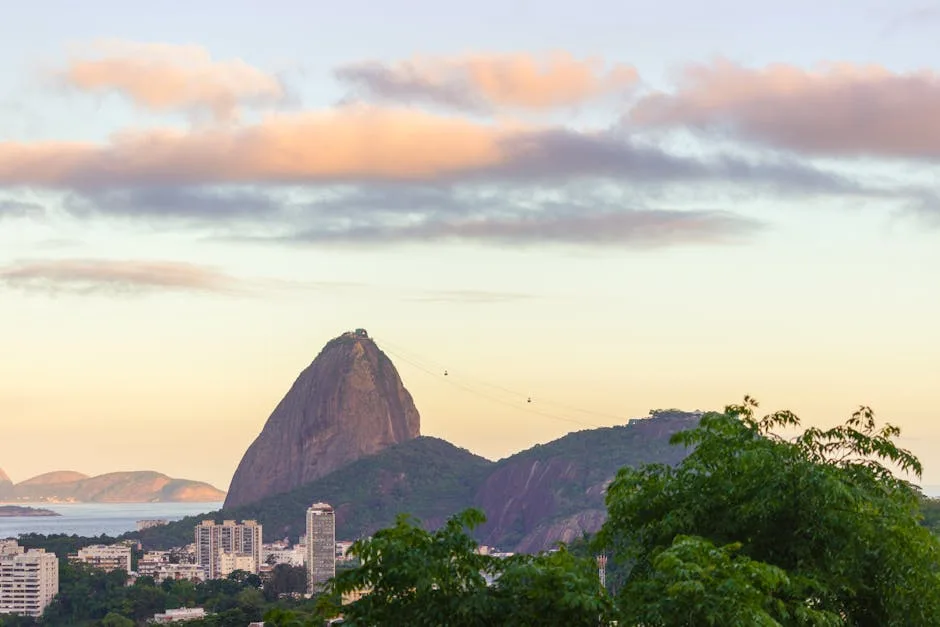Have you ever wondered about the best time to visit Rio de Janeiro? The answer isn’t as straightforward as it might seem, as this tropical metropolis offers completely different experiences depending on when you choose to discover its magic.
Rio de Janeiro functions as a year-round destination, but each season brings its own advantages and special characteristics. From the world-famous Carnival to sunny winter days, the Marvelous City always has something extraordinary to offer visitors eager to uncover its unique charms.
Understanding Rio’s Climate: Tropical with Distinct Personality
Rio’s Summer: Energy and Festivities
Summer in Rio (December to March) equals infectious energy and unforgettable celebrations. Temperatures range between 25°C and 35°C (77°F to 95°F), creating the perfect environment for enjoying the famous beaches of Copacabana, Ipanema, and Leblon.

During this period, the city pulses with special energy. This is when the world-renowned Carnival transforms Rio into the global epicenter of joy. Samba schools parade through the Sambadrome, street blocks take over neighborhoods, and the entire city becomes one massive celebration.
However, summer also brings intense tropical rainfall, especially during December and January. These summer rains are typically quick and refreshing but can be torrential. It’s important to stay prepared with umbrellas and quick-drying clothing.
Beaches become crowded during summer, particularly on weekends and holidays. Copacabana and Ipanema can get extremely busy, but this is part of Rio’s authentic experience. For those seeking less crowded beaches, Joatinga, Recreio, and Barra da Tijuca offer excellent alternatives.
The summer atmosphere is electric, with beach vendors, live music, and spontaneous celebrations happening constantly. New Year’s Eve at Copacabana draws over 2 million people for one of the world’s largest fireworks displays.
Autumn: Perfect Balance
Autumn (March to June) offers what many consider the ideal weather conditions for visiting Rio. Temperatures become more comfortable, ranging between 20°C and 28°C (68°F to 82°F), and rainfall decreases significantly.
This period is perfect for outdoor activities like hiking in Tijuca National Park, visiting Christ the Redeemer and Sugarloaf Mountain, and long walks along Copacabana’s shoreline. The drier climate and pleasant temperatures make experiences much more comfortable.
Beaches become less crowded after Carnival, allowing for more relaxing experiences. It’s the perfect period for those wanting to explore Rio without summer crowds while still enjoying ideal temperatures for beach activities.
During autumn, cultural events gain prominence. Rock in Rio (when it occurs), film festivals, and art exhibitions take advantage of milder weather for outdoor events.
Winter: Surprising Rio Tropicale
Rio’s winter (June to September) can positively surprise those unfamiliar with the city. With temperatures between 18°C and 25°C (64°F to 77°F), the climate remains pleasant for most activities, especially during daytime hours.
This is considered by many the best time to visit Rio de Janeiro if you seek dry weather, blue skies, and comfortable temperatures. Rainfall is extremely rare, and sunny days are almost guaranteed. It’s the ideal period for urban tourism, museum visits, and exploring historic neighborhoods like Santa Teresa and Lapa.
Beaches during winter have special charm. Although water is cooler for swimming, beaches become perfect for walks, sports, and relaxation. Many locals use this period for stand-up paddling, beach volleyball, and beach soccer.
Winter also brings gastronomic festivals, indoor cultural events, and intense nightlife. Ipanema bars, Lapa music venues, and Santa Teresa restaurants become livelier with local residents and tourists seeking the city’s nighttime activities.
Clear winter days offer spectacular views from Rio’s viewpoints. Sugarloaf Mountain and Christ the Redeemer provide crystal-clear panoramas of the city and coastline.
Spring: Renewal and Preparation
Spring (September to December) marks the return of higher temperatures and gradual increase in rainfall. It’s a transitional period offering excellent opportunities for those wanting to avoid summer crowds while still enjoying good weather.
During spring, the city prepares for summer. Samba schools intensify rehearsals, carnival blocks begin organizing, and the city’s energy gradually increases.
Events and Festivals: Planning Your Visit
Carnival: The World’s Most Famous Party
Rio’s Carnival traditionally occurs between February and March, with dates changing annually according to the lunar calendar. This is undoubtedly the most iconic time to visit Rio, but also the busiest and most expensive.
Samba school parades at the Sambadrome are the highlight, but true magic happens in the streets. Over 500 street blocks spread throughout the city, from traditional Santa Teresa blocks to mega blocks in Copacabana attracting millions of people.
For those planning to visit during Carnival, booking accommodation well in advance is essential. Prices can be 3 to 5 times higher than normal, and availability sells out quickly.
The Carnival experience extends beyond parades. Street parties, costume balls, and impromptu celebrations occur throughout the city. Each neighborhood has its own character and style of celebration.
Rock in Rio: Music and Energy
Rock in Rio, when it occurs (generally every two years), transforms the City of Rock in Barra da Tijuca into the stage for major international shows. The event attracts visitors worldwide and coincides with a period of great city movement.
Copacabana New Year’s Eve: Spectacular Celebration
Copacabana’s New Year’s Eve is one of the world’s largest New Year parties, gathering over 2 million people on the beach. Fireworks are launched from boats positioned along the shore, creating an unforgettable visual spectacle.
The celebration begins days before December 31st, with concerts and events leading up to the main event. Wearing white is traditional, symbolizing peace and good luck for the new year.
Rio’s Anniversary: March Celebration
The city’s anniversary (March 1st) is celebrated with special events, free concerts, and cultural activities throughout the city. It’s an interesting time to experience Carioca pride in their city.
Practical Aspects for Each Season
Summer: Preparation and Care
During summer, preparation for heat and humidity is essential. High SPF sunscreen, hats, light cotton clothing, and plenty of fluids are indispensable. Tropical rains can be intense, so always carry an umbrella or rain jacket.
Beaches become extremely busy. Arrive early (before 9 AM) to secure a good spot on the sand. Lifeguard stations serve as location references – each has its own distinct personality.
Public transportation becomes more crowded during summer, especially metro and buses serving beaches. Consider using ride-sharing apps or walking when possible.
Air conditioning in hotels, restaurants, and shopping centers runs constantly, so bringing a light sweater for indoor spaces is wise.
Winter: Taking Advantage of Ideal Climate
Winter is perfect for activities requiring more physical energy. It’s the best time to climb Sugarloaf Mountain on foot, hike in Tijuca Park, or explore the hills of Santa Teresa.
Mornings can be cooler, especially in July and August. A light jacket is recommended for early morning, but can be quickly discarded when the sun warms up.
This period is ideal for gastronomic tourism. Santa Teresa restaurants, Ipanema bars, and Lapa music venues become more comfortable without intense summer heat.
Rain and Storms: How to Prepare
Rio’s rainfall can be intense, especially during summer. Tropical storms are quick but strong, potentially causing flooding in certain city areas.
Some regions are more prone to flooding, such as parts of the North Zone and certain low-lying areas. Stay informed about weather conditions through local apps or news broadcasts.
When it rains, many outdoor activities become compromised. It’s useful to always have an indoor “Plan B,” such as museum visits, shopping centers, or cultural centers.
Budget Considerations by Season
High Season: December to March
During high season, especially Carnival and New Year’s, prices skyrocket. Accommodation, restaurants, and even transportation become significantly more expensive. Hotels in Copacabana and Ipanema can cost 5 times the low season price.
Booking everything with maximum advance notice is important. Many establishments require minimum stays during peak periods, especially during Carnival.
Carnival packages offered by hotels often include breakfast, parties, and sometimes parade tickets, providing better value than booking separately.
Low Season: May to September
Low season offers excellent value for money. Accommodation becomes cheaper and more available, restaurants offer promotions, and the city becomes more accessible for budget-conscious tourists.
This time is ideal for those wanting to explore Rio unhurriedly, discovering neighborhoods, museums, and attractions with more tranquility and economy.
Intermediate Season: March to May and September to November
Intermediate periods offer good balance between weather, prices, and availability. You can find good accommodation deals while still enjoying pleasant temperatures and less rainfall.
Season-Specific Activities
Beaches and Water Sports
Summer is obviously ideal for beach activities. Surfing in Barra da Tijuca, stand-up paddling at Rodrigo de Freitas Lagoon, and beach volleyball in Copacabana are at their peak.
During winter, beaches become perfect for walks, jogging, and sports not involving water. Many take advantage of opportunities for beach tennis or simply relaxing in the sun without excessive heat.
Water temperatures remain comfortable year-round for most people, ranging from 21°C (70°F) in winter to 26°C (79°F) in summer.
Hiking and Mountain Activities
Winter and autumn are ideal for hiking. Pedra da Gávea, Tijuca Peak, Sugarloaf Trail, and Parque Lage become more comfortable for long walks.
During summer, hiking should be done early morning or late afternoon to avoid intense heat and possible storms.
Popular hiking destinations include the Tijuca National Park, which offers various trail difficulty levels, from easy walks to challenging climbs requiring guides.
Nightlife and Cultural Scene
Rio’s nightlife functions year-round but gains special intensity during summer. Open-air bars in Ipanema and Leblon become packed, and beach parties are frequent.
During winter, nightlife concentrates more in indoor venues. Lapa music houses, Santa Teresa bars, and Barra clubs become busier.
The cultural calendar varies by season, with outdoor festivals common in cooler months and indoor exhibitions and concerts during rainy periods.
Gastronomic Tourism
Winter is perfect for exploring Carioca cuisine. Restaurants become more comfortable, and you can better enjoy gastronomic fairs and culinary events occurring outdoors.
During summer, prefer air-conditioned restaurants or open spaces with good ventilation. Beach kiosks offer authentic experiences with snacks and cold drinks.
Clothing Tips by Season
Summer: Lightness and Protection
Light clothing made of cotton or breathable fabrics is essential. Caps or hats, sunglasses, and comfortable flip-flops are indispensable. For beaches, always have sarongs, sunscreen, and water bottles.
For summer nightlife, light but elegant clothing works well. Many establishments have strong air conditioning, so a light sweater can be useful.
Winter: Layers and Versatility
During winter, the layering system works perfectly. T-shirt, light sweater, and a jacket that can be easily removed as the day warms up.
Closed shoes are more comfortable for long walks, especially if you plan hiking or exploring mountainous neighborhoods like Santa Teresa.
Rain: Essential Preparation
Regardless of season, always carry a compact umbrella or rain jacket. Quick-drying footwear or waterproof sandals are very useful during storms.
Avoid clothing made from materials that take long to dry, such as heavy jeans, during rainy periods.
Choosing Your Ideal Moment
For Families with Children
Autumn and winter are ideal for families. Milder climate makes outings more comfortable for children, beaches become less hectic, and there’s less risk of intense storms.
Summer can be challenging with small children due to heat and crowds, but offers the most authentic Rio tropical experience.
For Romantic Couples
Winter and autumn create more romantic atmospheres. Sunsets at Sugarloaf Mountain, dinners in Santa Teresa, and walks around Rodrigo de Freitas Lagoon become especially magical with mild weather.
For Adventurers and Sports Enthusiasts
Winter is perfect for hiking, climbing, and mountain sports. Autumn also offers excellent conditions for intense physical activities.
For water sports, summer and spring are ideal, with warmer water and favorable maritime conditions.
For Party and Culture Lovers
Carnival is unique and unmissable for those seeking the most intense cultural experience. Summer offers infectious energy and constant celebration.
Winter concentrates indoor cultural events, gastronomic festivals, and more sophisticated nightlife.
Making Your Decision
Rio de Janeiro offers unique experiences any time of year. Choosing the best time to visit depends on your travel style, budget, and personal preferences. Whether under the scorching summer sun or in the mild winter climate, the Marvelous City always has something special to offer those who arrive with open hearts to discover its infinite charms.
Each season reveals a different facet of this unique tropical metropolis, where exuberant nature, vibrant culture, and warm hospitality combine to create experiences forever etched in the memory of those fortunate enough to know it.
Consider your priorities: if experiencing Carnival and peak beach culture excites you, brave the summer crowds and heat. If comfortable exploration and better prices appeal to you, winter provides ideal conditions. For balanced weather and moderate crowds, shoulder seasons offer the best of both worlds.
Regardless of when you visit, Rio’s spirit remains constant – a city that embraces visitors with infectious joy, stunning natural beauty, and cultural richness that transforms every traveler who experiences its magic.







